Getting Black and Blue – without injury!

Scabious 'Mariposa violet' found a new home in front of a black bugbane. 'Butterfly blue' would be even more stunning.
I found myself wandering around the garden yesterday with a wheelbarrow full plants in need of a new home – a lonely blue star juniper, a beautiful blue scabious just starting to bloom and several sections of a blue hosta. The question was, where should I put them? Sound familiar?
I spend a lot of my time helping homeowners who have done too much plunking over the years. You know – plunk it here, plunk it there. There’s a hole – plunk.
My philosophy is simple – have a reason for putting plant A with plant B (and “because there was a space” does NOT count as a reason!)
Blue is an easy color to blend into the garden, looking as much at home with delicate pastels as with jewel tones. I especially like to see it being used to break up what can easily become a monotonous purple and chartreuse color scheme. Add a little blue in there and suddenly it seems fresh.
I wanted something different and I found it; BLACK and blue. I’ll spare you the obvious puns about bruises.
I first noticed how well black and blue went together when I planted blue bellflowers (Campanula persicifolia) in front of a stand of inky black bugbane (Cimifuga racemosa ‘Hillside black beauty). The bellflower brought out the blue tones within the black foliage while the flower color seemed more vibrant when seen against its dark companion. It became one of those gardening ‘Aha’ moments.
So the scabious and hostas got tucked in next to a mature group of bugbane and my blue star juniper is going to front a stand of ‘Passionate’ cape fuchsias (Phygelius recta) which has remarkable black stems and dark greeny-black foliage topped by orange fuchsia-like flowers which already have us on the hummingbird radar for miles around!
As with any plant combination, start with great foliage and you’re half way there.
Ideas for shady sites.
Include some of these in containers for close-up appreciation; 'Midnight blue' wishbone flower (Torenia sp.) is a favorite of mine and looks wonderful mingling with black mondo grass (Ophiopogon planiscapus 'Nigrescens').
Other shade loving black and blue plants include hydrangeas, the tropical looking elephant ears (Colocasia esculenta) and the wonderful spring bulbs such as bluebells, Camassia and anemone blanda
Ideas for sunny sites
Foliage and flowers are obvious options but consider planting a stand of black bamboo in a large blue container.
There are many other black and blue options for sun including;
The shrub 'Black lace' elderberry (Sambucus racemosa), annual blue fanflower (Scaevola sp.) and perennial blue speedwells (Veronica sp.)
Solo performers
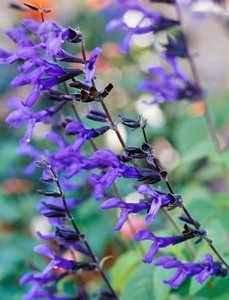
'Black and blue' sage brings an intense color punch to sunny gardens. Imagine this rising from a carpet of black mondo grass
Then there are a couple of plants who have it all in one tidy package. ‘Black and blue’ sage is an annual in my area but worth including for all the hummingbirds it attracts.
‘Caradonna’ sage is a more reliable perennial and carries rich blue flowers along the length of its tough black stems. It blooms throughout the summer unlike some other varieties. All sages are deer resistant – a bonus for my garden. Still talking to the exploding rabbit population about their diet…
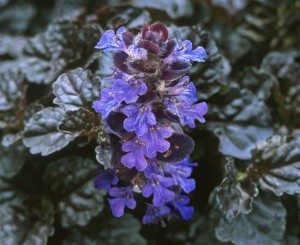
'Black scallop' bugleweed has wonderful crinkled black leaves and deep blue spring flowers - a favorite evergreen perennial for damp shade
There are also several varieties of bugleweed (Ajuga reptans) which are almost black such as ‘Black scallop’ and ’Metallica’. In spring the foliage is studded with short fat spikes of blue flowers. Bugleweed loves moist conditions in partial shade. I am using it as a groundcover on my stream banks in the hope of suppressing weeds but it’s also a popular addition in shade containers.
What's your favorite black and blue?
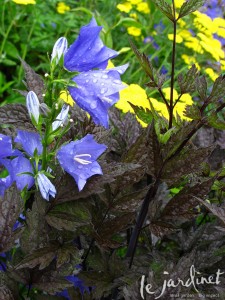
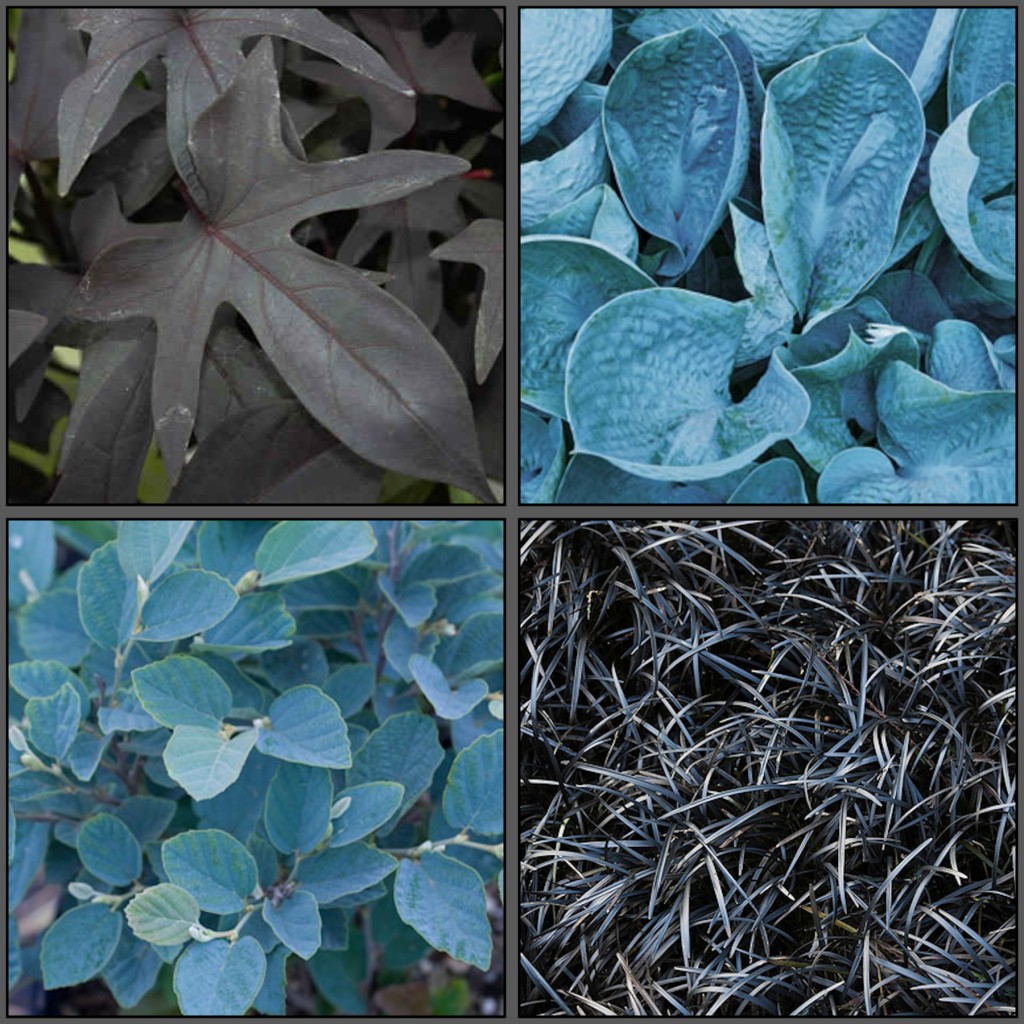
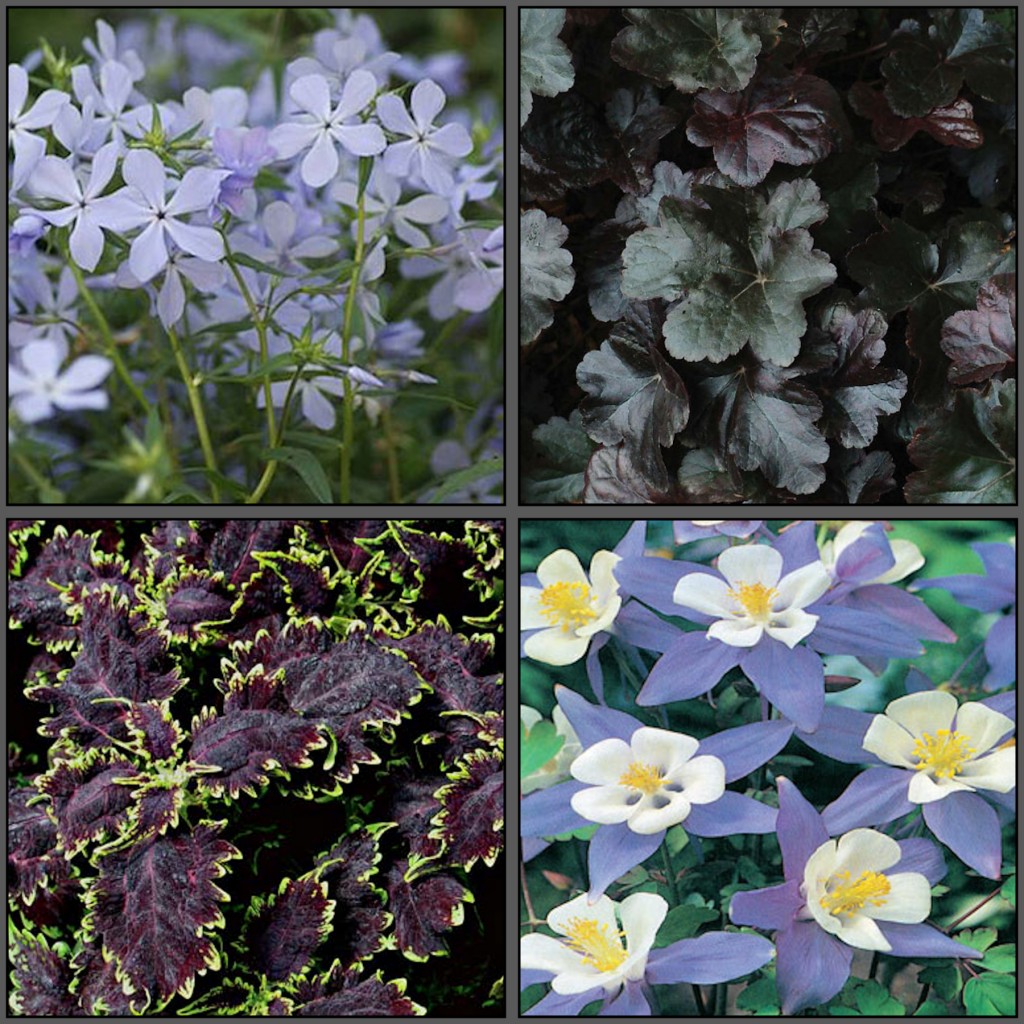
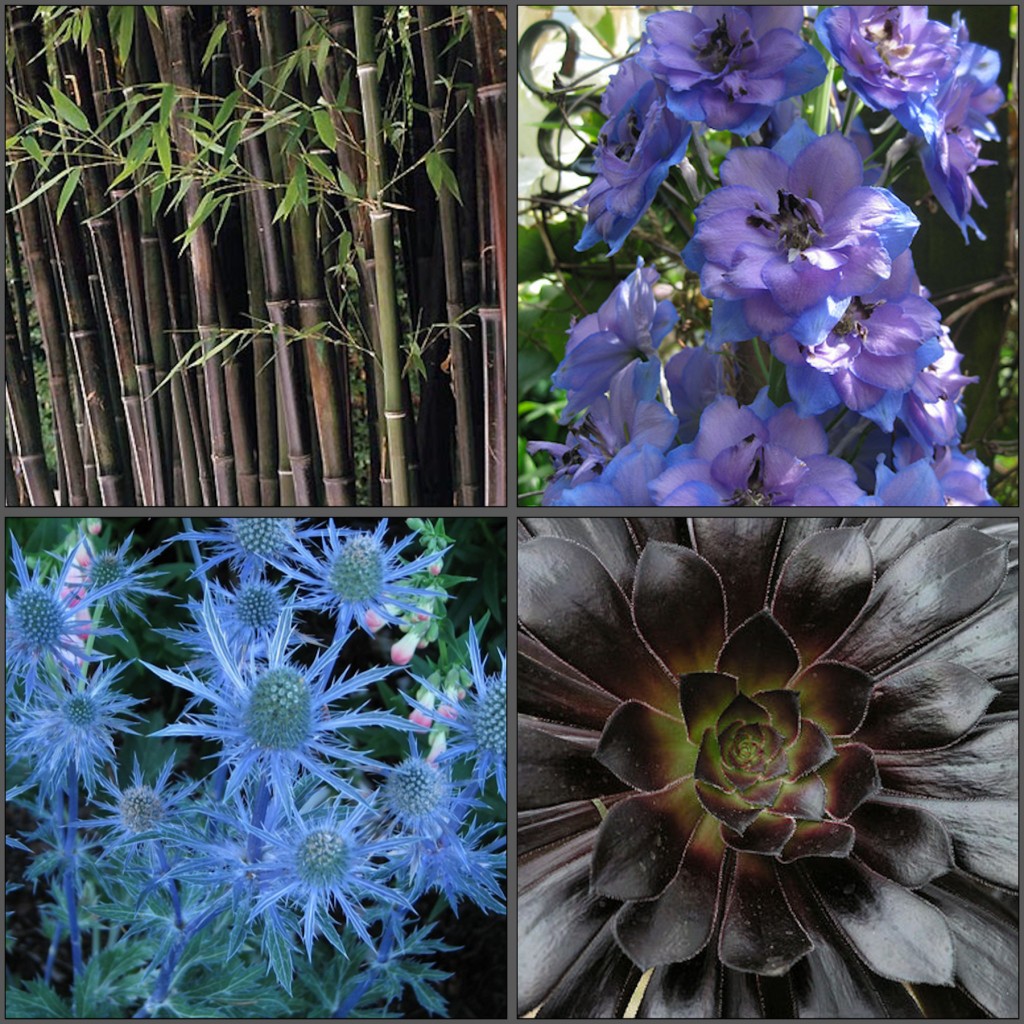
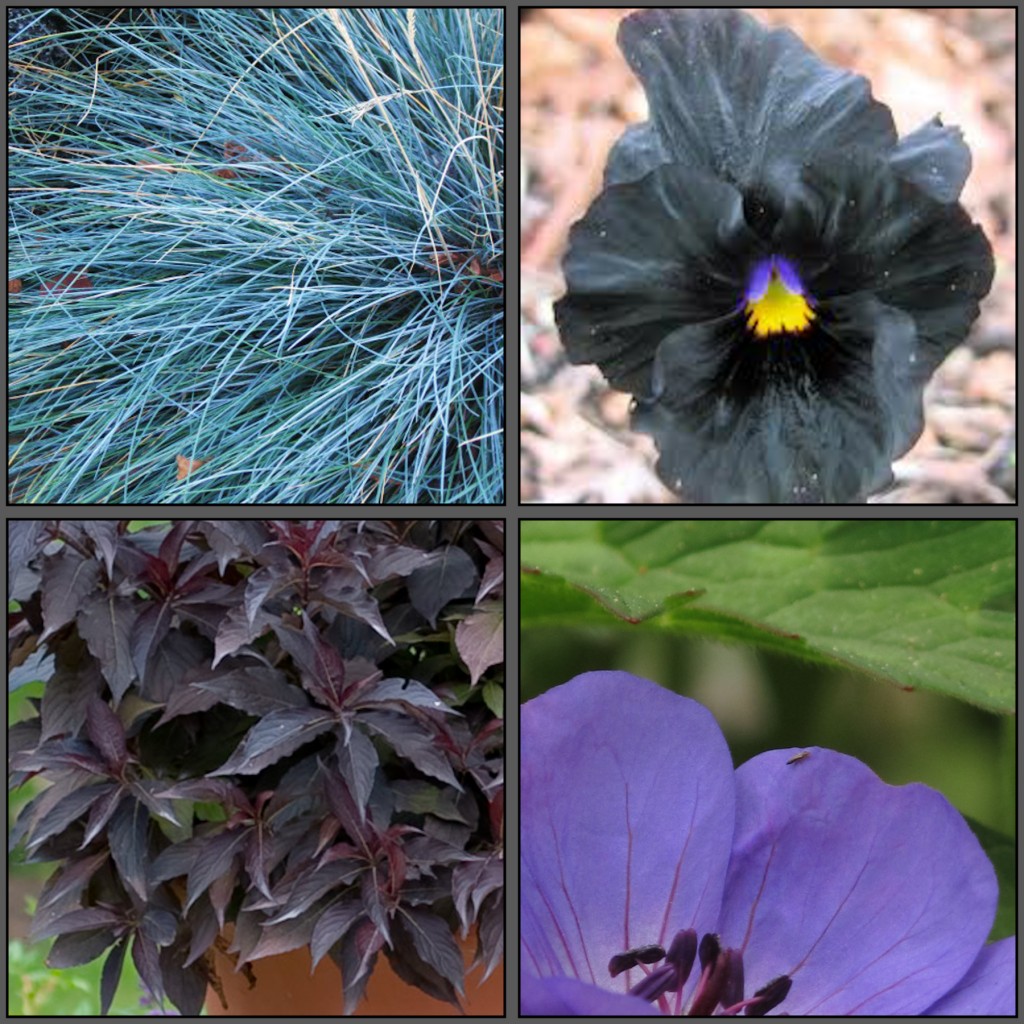
Such fantastic dark colours which all blend together so well with the blues. Inspiring combos! I think one of my favourites would have to be the Catmint which grows prolifically for me where other blueish things fail and falls out over paths and borders for months on end. Also many many thanks for your kindness, your comment on my blog was so much appreciated.
Catmint is a wonderful perennial! From the Six Hills Giant to Walker's Low, I love them all. They'd look great against say a black elderberry – or growing in a glossy black pot.
Take care of yourself – thinking of you.
Karen, I love black bamboo, and I think putting it in a large blue pot would look fantastic! How large a pot do you think I would need? I think of bamboo being a rampant spreader and needing lots of room.
There are a few tricks to having bamboo in a pot. I use a 'double potting' technique – keep the bamboo in a nursery pot e.g. 5g or 7g size and set that inside your decorative pot. Then when the bamboo needs dividing (or removing) you just have to pull out the nursery pot. So the size of your decorative pot depends on the size of your nursery pot…. Be warned though, the stalks DO grow out of the bottom of the nursery pot and will also leap over the top of it! Again there are tricks – email me if you'd like more detailed information on varieties, fertilizer etc.
I've very methodical about my plant combinations and it's always frustrating when a plant doesn't work out as well as I'd hoped since so much thought went into its placement, especially when I'm dealing with dry shade or some of my other difficult areas. I've already started making notes about what changes I need to make to the garden this fall. I don't have any plants with black features but that gives me more to think about for future design redo's. 🙂
Always happy to give you an excuse to buy more plants!
Hi Karen, I have not thought to mix black and blue before reading your post. It is a great combination. I have a Scabious plant, but it does not seem very happy about where I have "plunked" it. Recently I have particularly been struck by how critical location is to a plants success. Get the right spot and the plant takes off. Get it wrong and the plant dies sooner or later. I think you are right to remind us to consider foliage as much as flowers when planning a location.
Glad you enjoyed the post Jennifer. I found out about the importance of foliage in a design the hard way. Let's just say that was part of the inspiration for our new book Fine Foliage! (Feb 2013)
Great combination and photos to illustrate it. I think 'Black Scallop' is so superior to any other ajuga that it's the only variety I carry at my nursery now. It stays purple and ornamental all winter. The 'Blue Shadows' that i planted for a friend in Maine are gorgeous but all mine died. Not sure why. I like theme gardens for keeping my plunking in check. Then every few years I limit my self to only adding plants to existing groupings of the same plant—that really works well design wise.
Carolyn, your idea to periodically limit yourself to simply adding more of something you already have is a good one, especially for those of us with larger gardens. I've also made myself add another group of a plant I already have, perhaps farther down the border, to try and avoid the jelly bean effect,
Except for the sweet potato vine, I haven't tried plants with black foliage before — brown, yes, but that's been accidental… I like how the combinations with blue are striking without being garish. Great inspiration as always, Karen — when I can no longer sit on the patio because lush, beautiful containers take up all the space, I will know who to blame.
Still laughing Stacy!! I've been accused of worse.